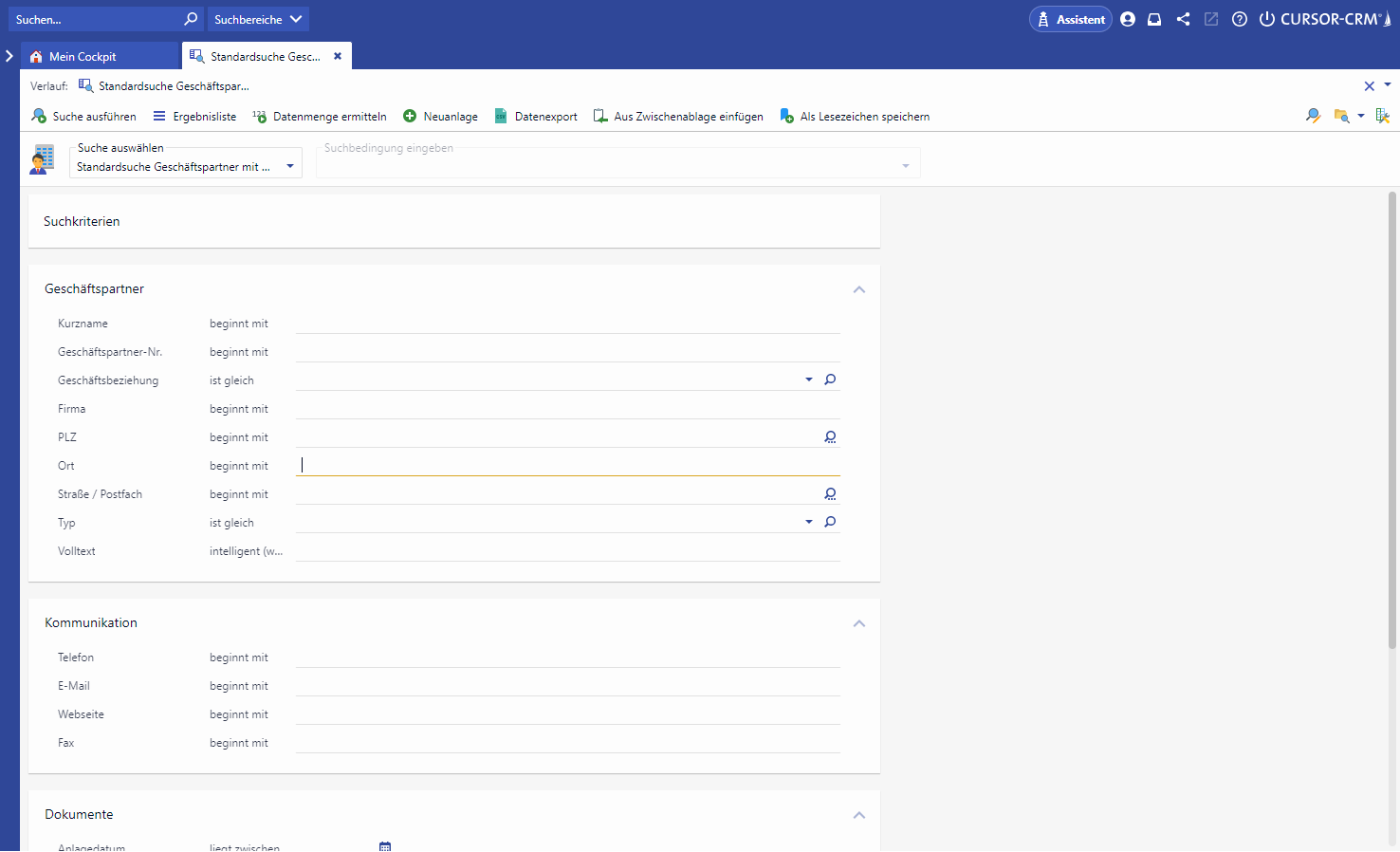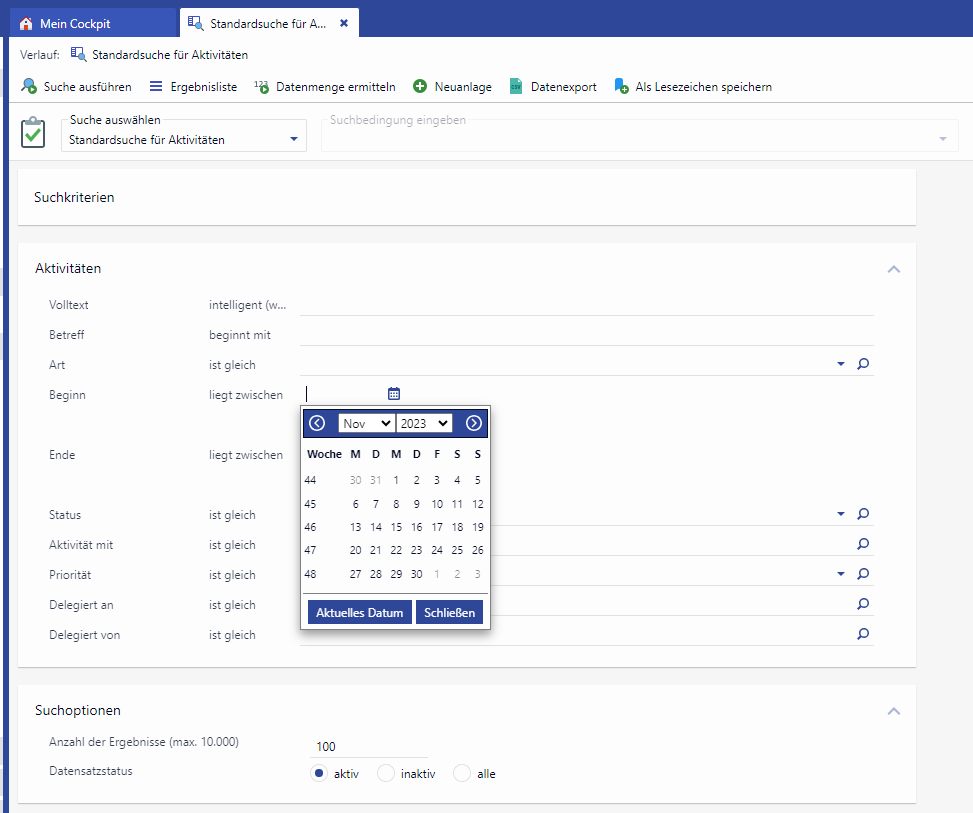Search in the Web Client
Basics
A search mask for a Default search opens automatically when an entity is clicked in the Area menu. In the search dialog, you can switch between two views:
Single field search (here you enter all search terms in one field, similar to known search engines).
If this search type is enabled, the view opens automatically.
Single field search in the business partner area
Extended search
You need to open this view using the button Advanced search. Specific search entries are possible here.
Advanced search in the business partner area
If the single field search has not been enabled, the input window remains inactive. In this case, only Advanced Search is available.
If a default search is converted into a Quick search, it will only be displayed once in the Select search field.
By clicking the icon 
Single field search
These searches are characterized by the fact that the search condition is entered in a field.

Single field search in the Web Client
The single field search is especially helpful when you are looking for datasets in a specific information area (e.g. business partner). The dialog is opened when you select an information area from the File menu.
The search and the hit list are located in the same dialog.
How to start the single field search:
Select a desired information Area in the navigation area. The search dialog opens.
Press the keystroke CTRL+SPACE BAR. The menu with available shortcuts is opened.
Enter the desired shortcut and the corresponding search term.
Start the search by pressing the ENTER ↵ key.
OR
Click the icon Execute search. The hits are displayed in the list.
Keywords and operation of the single field search
If preconfigured accordingly, the condition about keywords is automatically split into several search fields in the background when the search is executed. The abbreviations marked as bold characters define the division of the search condition into pre-configured fields.
The search for a company might look like this:
Firma Cursor in Gießen
The search conditions Cursor and Gießen are divided into the fields Company and City.

The selection of keywords has been optimized in the single field search so that registered parts of a keyword are recognized and the keyword list is displayed filtered.
Detailed description of the keyword selection:
When entering the initial part of a keyword, for example, "Com" for "Company", this will be recognized and then only the keywords that correspond to the entered text will appear.
Furthermore, the first entry of this filtered suggestion list is focussed so that it can be selected directly with the ENTER ↵ key.
(The rare case of a match between the beginning of this text and a deliberately desired input text, e.g. place, is accepted here.)↹ TAB key behaves similarly to ENTER ↵ when selecting a suggestion.
ARROW LEFT ← or ARROW RIGHT → moves the cursor in the input field so that text changes can be made.
For some fields several shortcuts can be deposited. With that you can create the search more intuitive.
Extended search
Advanced Search is a search where you can explicitly distribute search terms to the search fields.
To start the Advanced Search:
Click the Advanced Search button. The search dialog opens.
Type the search terms into corresponding fields.
Start the search by pressing the ENTER ↵ key.
OR
Click the icon Execute search. The hits are displayed in the list.
To be able to select inactive datasets, you must have the action right Administrate searches and reports (search mask). In this case, the dataset status appears in the search options (active, inactive).
Change result number
In order to keep the amount of data to be transmitted as small as possible but still to provide a reasonable search result, the number of returned datasets is limited to 10,000. If a search without search criteria is unsuccessful, you should refine your search until the desired dataset is found or ensured that the dataset does not exist in the system.
You may have additional action rights (Changing search result limit) to increase the number of results over the 10,000. If you have withdrawn any action rights for this field, you may not make any adjustments.
Affected search dialogs:
Field Number of results in search dialog for areas
Field Number of results in the search dialog for reports
Determine data volume
Click the button 
Search operators
starts with | Searches all terms beginning with the characters entered. |
|---|---|
is one of | The term must match one of the entered values. The IN function used here therefore allows several parameters to be specified for lookup fields in one condition. Example: You want to see your open activities. These are all activities where either O or A has been entered in the Status field. So you need an operator to perform an OR query. ‘Is one of' meets this criterion. |
is equal to | The value to be searched must exactly match the input. Validation is carried out for key fields. This means: if a key is incomplete or incorrect, a lookup browser is displayed. |
contains | Searches all terms that contain the string you entered. |
is less than | Can be used for date fields and number fields. |
is between | Searches all terms that are between the entered values (including those values). |
Wildcard Search | Searches all terms over all entities and fields that have been indexed. |
Search mask for activities
In the case of the search mask for activities, some special features have to be considered.
To enter appointments, use the calendar popup window.
To enter today's date, use the space bar.

Search mask for activities with calendar popup
Tip
Use the keystroke to enter the desired date and time. A detailed description can be found in the section Keystrokes (Web Client).
Display of the search result (detail or list view)
When the search result is taken from the search mask, it is now consistently controlled whether the display takes place in the detail or list view.
Behavior:
For a dataset, the search result is displayed directly in the detail view,
for several datasets the list view is used.
Initial focus of search fields in search masks
The first search field (= text field) of a search mask is focused in the following cases:
When switching from single field search to advanced search.
When opening a search mask for which no single field search is configured.
Inserting multiple entries in "is one of"
Several entries in the clipboard can be inserted in the case of the search operator "is one of" via an action. For lookup fields, invalid values are filtered out with a hint message like the attempt to insert alphanumeric values into numerical fields. The fields have been extended by a button that opens the input popup. In this popup, the values can be entered. Each line corresponds to a value. Blank lines are allowed. Depending on the field type, the values entered are validated. Values that could not be transferred are displayed in a notification.
The permitted data types of the fields are "String", "Integer" and "Double" and are all supported in the lookup fields (picklist fields, lookup on key table and lookup on entities). You can also use the popup directly to type in several values, which is a huge advantage.

Popup for entering multiple entries for "is one of” and "is not one of"
